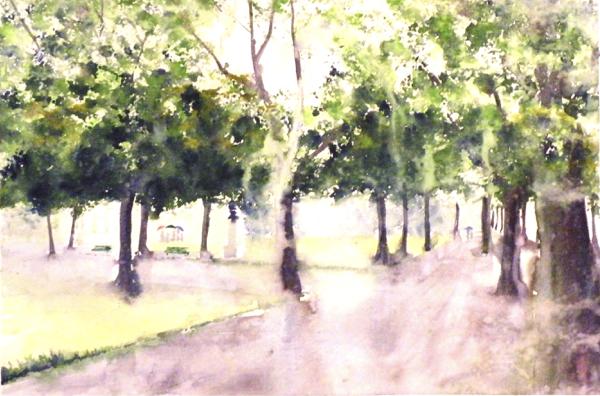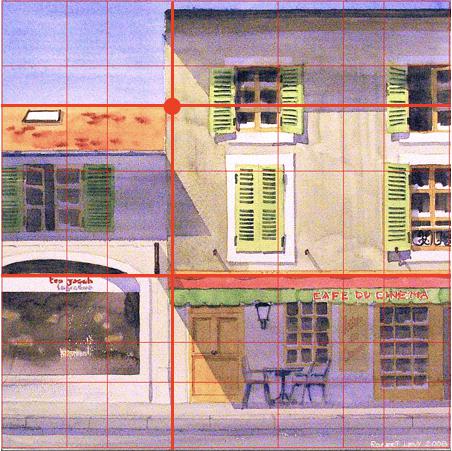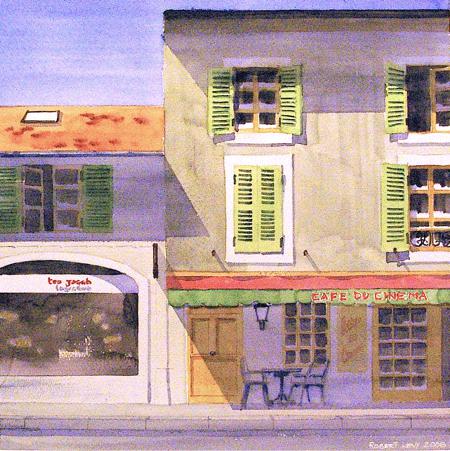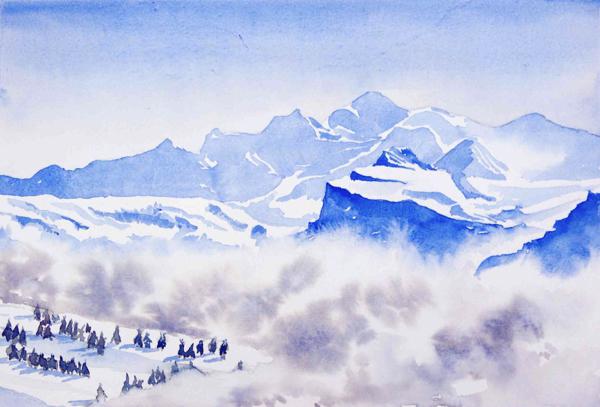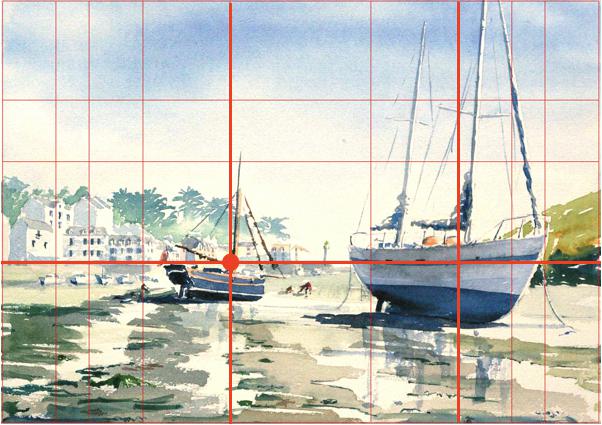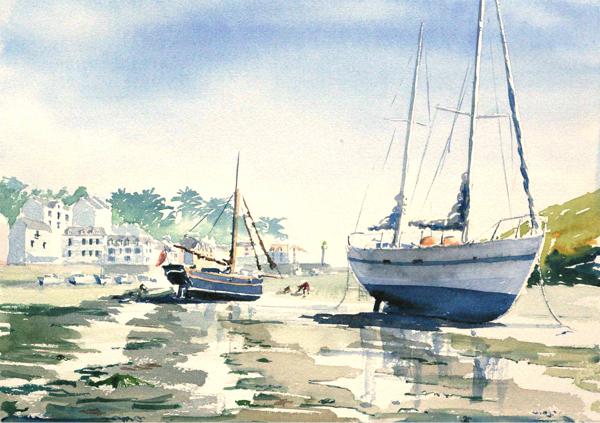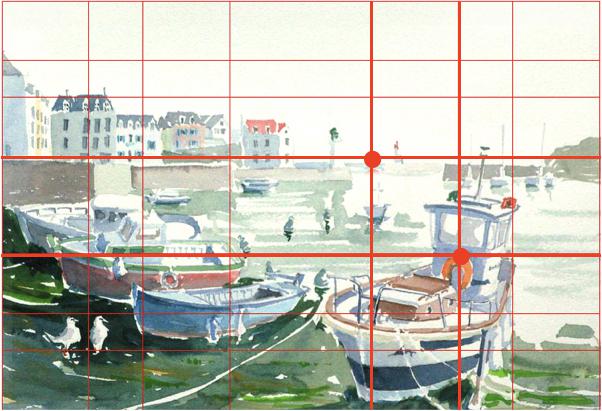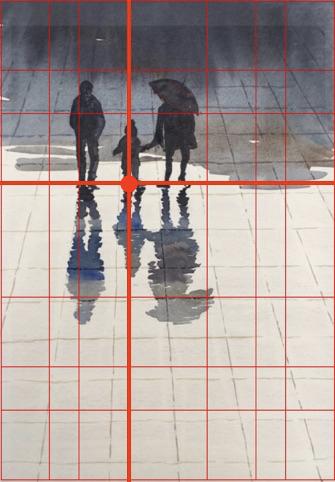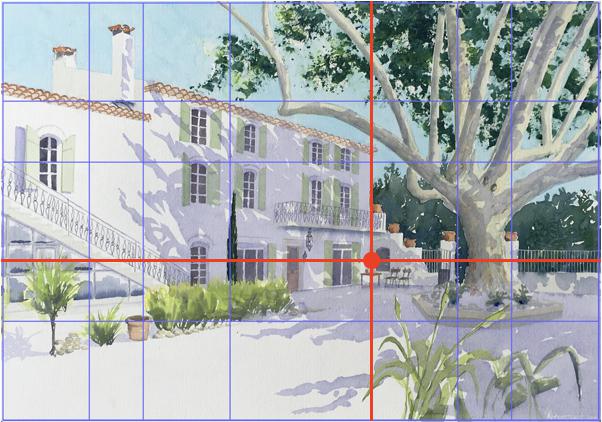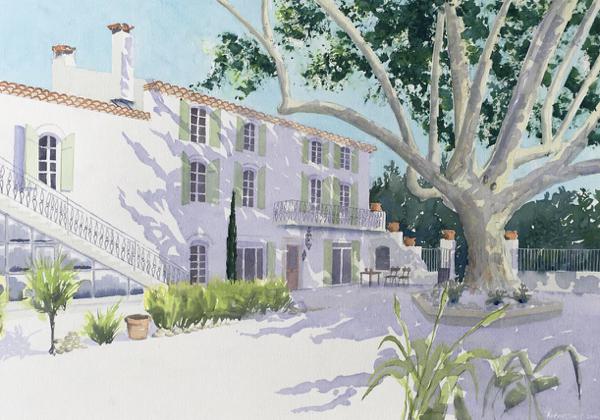The examples
Examples of the use of human proportions in structuring a work are numerous in the history of painting. Is it pure chance, or a "secret of manufacture" that the masters bequeathed to their students ?

In the picture gallery below, these various examples of structure show you how the watercolorist wanted to place the centers of interest and the lines of force of his watercolors.
Click on these images to start the slideshow.
The structure of each of these watercolors is analyzed more finely at the end of this slideshow.
Note that if the regulating lines system is always the same, the watercolorist does not use all the possibilities of the structure to place the centers of interests. Indeed, fewer are the points and lines of force, more readable is the final result !
Before analyzing the structure of the watercolors below, let us describe the different lines of force (golden lines) of this regulating lines system :

The red lines are called primary golden lines (left, right, top and bottom). They result from the division of the external dimensions of the external rectangle by 1,618, the Golden number.
The blue lines are the secondary golden lines, and the green lines are the tertiary golden lines.
The intersection of lines of the same color are called golden dots. These dots correspond to the different points of interest (focal points) of the painting determined by the painter.
Each of the watercolors analyzed below is presented with and without their lines of structure, in order for you to apprehend both the reflection of the painter and the final result.
Click on the images below to enlarge.
The Parc des Bastions in Geneva, Switzerland.
The horizon line is located on the low primary golden line, and the main vanishing point is situated at the intersection of the horizon and the right secondary golden line. The eye is attracted by the unique vanishing point on the horizon line, showing the apparent outcome of the scene painted in this torrential rain.
Detail of Saint Joseph street in Carouge, Switzerland.
The two buildings meet on the left primary golden line. The roof of the small house is aligned with the upper secondary golden line. The corner of blue sky, at the top left of the painting, indicates the position of the summer sun that illuminates the street.
Place du Molard and the Molard Tower in Geneva, Switzerland.
The main focus is the porch of the tower. It is located at the intersection of the lower secondary golden line (wich is also the horizon line) and the left secondary golden line. The adjacent tower aligns with the left tertiary golden line. The gap in the sky, in the form of a "V", gives breathing to the composition. The sky is not painted so as not to complicate the whole painting.
The Mont Blanc chain, seen from Les Chavannes in Les Gets, France.
The eye is first attracted by the summit of the Mont Blanc, wich is situated at the intersection of the right primary golden line and the high secondary golden line. The fog invading the valley is contained between the low margin of the painting and the lower primary golden line.
The harbour of Sauzon at low tide. Belle-Ile-en-mer, France.
The main subject of the painting is the small ketch on the left. The base of its mast is at the intersection of the lower primary golden line (horizon line) and the left primary golden line. The position of the horizon line makes it possible to emphasize in the foreground the puddles of water, which also serve as vanishing lines which direct the gaze towards the opening of the harbour.
The two masts sailboat on the right is contained between the primary right and right tertiary golden lines, which allows leaving a margin on the right so as not to "decentralize" too much.
Another view of the harbour of Sauzon at low tide. Belle-Ile-en-mer, France.
Here, two points of interest: the exit of the harbour, between the two lighthouses, and the boat stranded on the right. The exit to the sea is indicated by the intersection of the high primary golden line (horizon line) and the right primary golden line. The center of the cabin of the right boat is at the intersection of the low primary golden line and the right secondary golden line. Placing the horizon high enough to highlight the boats in the foreground, aligned on an invisible arc of circle.
Reflections game in the rain (from an anonymous photo).
Between the three silhouettes, the eye is attracted by the smallest one. The child and its reflection are located on the left primary golden line. The base of the silhouettes aligns with the higher primary golden line. The placement in height of this center of interest makes it possible to imagine the continuation of the march of the small group towards the "reader".
Heat and shade of summer in Sainte Cécile les Vignes, France.
The main center of interest is the small corner of shade where two glasses and a bottle await the visitor on a table in the cool shade of the plane tree. In order to leave room to describe the house, but also the heat of the ground in full sun, the horizon line is placed on the low primary golden line. The center of interest coincides with the corner of the house and the low wall, which forms a refuge for the visitor. The right primary golden line makes it possible to delimit the house while giving the tree the place to impose itself and to protect the house.
.jpg)
.jpg)
.jpg)
.jpg)





